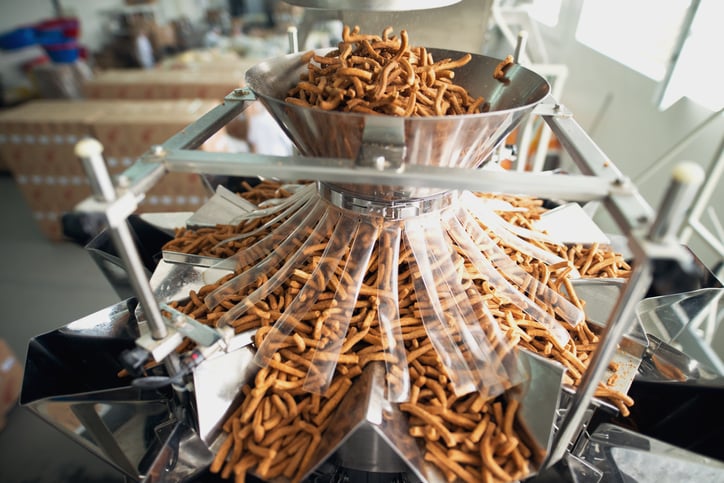
From hidden inflation at the grocery store to AI breakthroughs in sustainable materials, March was a big month for bulk material news—whether consumers noticed or not. Economic pressures, health trends, and technological advances are reshaping how products are made, priced, and consumed. In case you missed the headlines, we’ve rounded up five key stories that reveal where the industry is headed—from shrinkflation in your snack aisle to AI-driven bioplastics and evolving pharma regulations. Let’s dive into what mattered most in March.
The shrinkflation phenomenon
Shrinkflation is a growing trend where companies reduce the size or quantity of products while keeping prices the same, effectively raising the cost per unit without alerting consumers. Examples include Snyder’s pretzels shrinking from 12 oz to 11.25 oz, Sun-Maid Raisins dropping from 22.58 oz to 20 oz, and Domino’s cutting their $7.99 wings from 10 pieces to 8. These subtle changes often go unnoticed, yet they represent a hidden form of inflation that affects everyday purchases.
Consumer advocate Edgar Dworsky documents these changes on his site, MousePrint, bringing attention to how widespread and varied shrinkflation has become. The phenomenon has also sparked lively discussions in online communities like the r/shrinkflation subreddit, where users share new examples and vent their frustrations. As companies try to manage rising production costs without visibly raising prices, consumers are left with less product for the same money—and a growing sense of distrust.
AI’s Role in Bioplastics Development
Artificial intelligence (AI) is revolutionizing the development of sustainable bioplastics by expediting the discovery and design of polyhydroxyalkanoates (PHAs), a biodegradable alternative to conventional plastics. Researchers have employed multitask deep neural networks (DNNs) trained on nearly 23,000 experimental data points to predict critical properties—such as thermal stability, mechanical strength, and gas permeability—of a vast chemical space comprising 1.4 million polymer candidates. This AI-driven approach enables the identification of PHA-based materials that closely match the performance characteristics of traditional plastics like polyethylene and polypropylene.
The integration of AI not only accelerates the screening process but also enhances the feasibility assessment of synthesizing these bioplastic alternatives. By focusing on candidates with known biosynthetic or chemical synthesis pathways, researchers have pinpointed 14 promising PHA-based materials capable of replacing petroleum-based plastics. This advancement underscores AI's pivotal role in addressing environmental challenges associated with plastic pollution, offering a pathway to develop eco-friendly materials without compromising performance.
Chips and cookies have gotten too expensive. Shoppers are buying less
In March 2025, CNN reported that major food companies like PepsiCo and Campbell Soup Company are experiencing a decline in snack sales. This trend is attributed to consumers becoming more health-conscious and seeking healthier alternatives, as well as the rising popularity of weight-loss drugs such as GLP-1s, which suppress appetite. PepsiCo's Frito-Lay division, known for products like Doritos and Cheetos, reported a rare annual sales decline in 2024. Similarly, Campbell's, which owns snack brands like Goldfish and Snyder's-Lance, has faced challenges in maintaining snack sales growth.
To adapt, these companies are investing in healthier, high-protein snack options to meet evolving consumer preferences. This shift underscores a broader change in the food industry, as traditional snack manufacturers strive to balance indulgence with health and wellness trends.
State of Treating report unveils future growth projection for US confectionery sector
In 2024, the U.S. confectionery industry achieved sales of $54.2 billion, as reported at the National Confectioners Association's State of the Industry Conference in Miami. Despite economic challenges and inflation concerns affecting consumer spending, 98% of shoppers purchased confectionery products during the year, indicating that treats like chocolate and candy remain integral to special moments. The industry anticipates continued growth, projecting a market value of $70 billion within the next four years.
However, financial pressures have influenced purchasing behaviors, with a noticeable shift from premium chocolates to more affordable candy options as consumers adjust their budgets.
Regulatory Trends in Pharma Manufacturing: Key Changes to Watch in 2025
The article highlights emerging regulatory trends in pharmaceutical manufacturing for 2025, driven largely by the industry's rapid digital transformation. Key regulatory bodies like the FDA and EMA are updating frameworks to accommodate the growing use of artificial intelligence, machine learning, and cloud-based platforms in drug development and production. These changes aim to ensure that innovations continue to meet rigorous standards for safety, quality, and efficacy, even as they reshape traditional manufacturing models.
Additionally, the article notes a global push toward greater transparency, data integrity, and harmonization of standards across regions. There is also increased focus on environmental sustainability and supply chain resilience, especially in light of recent global disruptions. Pharmaceutical companies are encouraged to stay agile and proactive, integrating compliance into innovation strategies to remain competitive in a shifting regulatory landscape.


